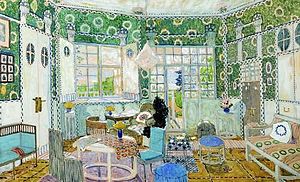Little Eyolf

Little Eyolf(Lille Eyolfin the originalNorwegiantitle) is an 1894playby NorwegianplaywrightHenrik Ibsen.The play was first performed in Norwegian on December 3, 1894, at a 9 a.m. matinee performance in theHaymarket TheatreinLondon.[1]
Plot
[edit]Little Eyolftells the story of the Allmers family. At the outset of the play, the father, Alfred, has just returned from a trip to the mountains. While there, he resolved to focus foremost on raising his son Eyolf, rather than continue work on his book,Human Responsibility.Eyolf, though described as having "beautiful, intelligent eyes",[2]is paralyzed in one of his legs, and thus his life is a sheltered one. He craves more than anything else to live the life of a normal boy, but his father knows that this is not possible. As such, Alfred wants to turn Eyolf towards loftier, intellectual pursuits.
The Allmers household is soon visited by the Rat-Wife, a woman capable of enchanting rodents into following her into the sea, where they drown. She leaves when informed that her services are unnecessary, and Eyolf follows her, unnoticed by Alfred, his wife Rita, and Alfred's sister Asta. Once Eyolf is gone, Alfred details his plan for being a better father to Eyolf and allowing him to attain happiness. In the course of his description, they are visited by Borghejm, an engineer, who is interested in Asta. While Asta and Borghejm walk outside, Rita's possessiveness of Alfred is revealed, during which she even wishes that Eyolf had never been born, as he diverts Alfred's attention from herself. Rita and Alfred's conversation is interrupted by the return of Asta and Borghejm, and then followed by sounds of shouts down by the sea, which reveal that Eyolf has drowned after following the Rat-Wife into the sea.
Down by the sea, Alfred mourns and is comforted by Asta. Rita and Borghejm follow, and once again Borghejm removes Asta from the action allowing for confrontation between Rita and Alfred. In the course of their conversation, Rita talks more about needing Alfred wholly while Alfred reveals that he married Rita in order to be able to better Asta's life. They also each blame each other for Eyolf's injury (as a baby, he fell off a table while they were making love), with Alfred accusing Rita of "luring me in to you",[3]distracting him from his duty to watch over Eyolf.
Borghejm and Asta return, and Borghejm is once again unsuccessful at convincing Asta to marry him. However, when asked by Alfred and Rita to stay with them and take Eyolf's place, somehow allowing them to ease their guilt and avoid the problems in their relationship, Asta decides to marry Borghejm and follow him north. With Alfred indicating a continued unwillingness to be the husband Rita desires, she shares her new plan to try to better the lives of the poorer children who live down by the sea. In this, Alfred sees something positive again in Rita, and Alfred decides to remain, so that together they can atone for their mistakes.
Characters
[edit]- Alfred Allmers
- Rita Allmers, his wife
- Eyolf, their son, nine years old
- Asta Allmers, Alfred's younger half-sister
- Borghejm, a road builder
- The Rat-Wife (said to be based onKristine Cathrine Ploug)
Adaptations
[edit]A production ofLittle Eyolfwas featured in theBBCtelevision anthology seriesPlay of the Monthin July 1982. It starsAnthony Hopkinsas Alfred,Diana Riggas Rita andPeggy Ashcroftin the role of the Rat Wife.[4]
Samuel Adamson'sMrs Affleck,which translates the action to the 1950s and set it on the English coast in Kent, premiered at theNational Theatrein January 2009 to mixed reviews.[5][6][7][8][9]Cast credits areClaire Skinneras Rita Affleck,Angus Wrightas Alfred Affleck, andNaomi Frederickas Audrey Affleck.[10]
The 1989 filmJazeere,directed byIndiandirectorGovind Nihlani,is a modernized take on the story. This Hindi version starred stalwarts likeRatna Pathak,Rajit Kapoor,Mita Vashisht,andIrrfan Khan.Vanraj Bhatiascored the background music for the film.
The 2009 filmThe Frost,directed by Spanish directorFerran Audí,is a modernized take on the story.
The 2016 Edinburgh Festival performanceLittle Wolfie,directed by Norwegian director Invi Brenna, is a contemporary adaptation for the 21st century.
See also
[edit]References
[edit]- ^"Globe", 8th December 1894, p. 6.
- ^Ibsen,Ibsen: The Complete Major Prose Plays,870.
- ^Ibsen,Ibsen: The Complete Major Prose Plays,909.
- ^""Play of the Month" Little Eyolf (1982) ".Retrieved2007-11-22.
- ^Benedict Nightingale(2009-01-29)."Mrs Affleck at Cottesloe".The Times.Archived fromthe originalon June 16, 2011.Retrieved2009-02-10.
is [Claire Skinner's] riveting portrait of a trapped woman enough to justify Marianne Elliott's strong, tense production?
- ^Michael Billington(2009-01-28)."Mrs Affleck".The Guardian.Retrieved2009-02-10.
- ^Susannah Clapp(2009-02-01)."Forgive and forget".The Observer.Retrieved2009-02-10.
Ibsen's 1894 play isn't often performed and it's not hard to see why.
- ^Charles Spencer(2009-01-29)."Drowning in gloom: Mrs Affleck at the National Theatre, review".The Daily Telegraph. Archived fromthe originalon 2009-08-28.Retrieved2009-02-10.
if you are feeling even marginally low in spirits, this is a play to avoid like the plague.
- ^Michael Coveney(2009-01-29)."Mrs Affleck, Cottesloe, National Theatre, London".The Independent.Archived fromthe originalon January 31, 2009.Retrieved2009-02-10.
Laden with fine writing, a keen dramatic intelligence and good acting, the show still never catches fire.
- ^""Mrs.Affleck National Theatre" (2009) ".Archived fromthe originalon 2008-12-16.
Bibliography
[edit]- Ibsen, Henrik(1978).Ibsen: The Complete Major Prose Plays.New York: Plume.ISBN0-452-26205-4.
External links
[edit]- Little EyolfatProject Gutenberg
 Little Eyolfpublic domain audiobook atLibriVox
Little Eyolfpublic domain audiobook atLibriVox- Little Eyolfat theInternet Broadway Database
